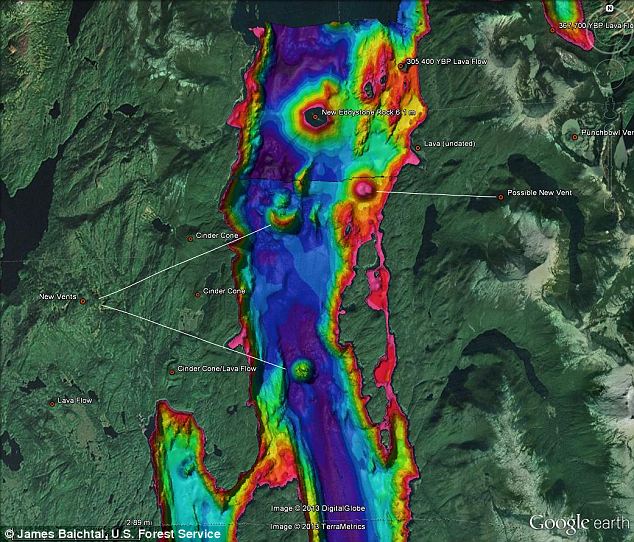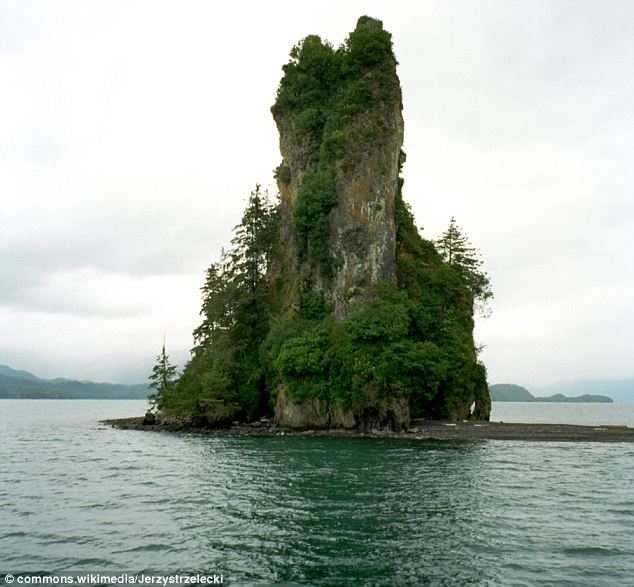Scientists find 12 new active volcanoes in Alaska and expect to keep finding more
- A team of researchers has found a new type of volcano in the rugged, northern state and more they look, the more they keep finding
- The most recently discovered example lurks just below the water of a canal that's constantly criss-crossed by cruise ship tourists
For proof that Alaska is the last American frontier, one need look no further than the 12 volcanos scientists have recently discovered in the remote and rugged state.
And its possible you've been right on top of some of them.
Thanks to years of work by scientists
at the United States Geological Survey and U.S. Forest Service, the
country can count a dozen more of the moody mountains among its natural,
and sometimes dangerous, outdoor wonders.

Did Juneau? Crisscrossing Alaska's southeast panhandle are 12 newly discovered mini-volcanoes and scientists say there are likely countless more
But mountainous may not be the most apt way to describe these newly discovered volcanoes.
In contrast to the enormous
stratovolcanoes in Alaska’s southwest—like Pavlof, an extremely active
peak that has made headlines for its volatility in recent weeks—many of
these new discoveries are more like ‘volcanic piles’ that dot the
state’s tiny islands and isolated coves.
Until now, the wilds of the Last Frontier, these volcanoes have remained blanketed in the state’s untouched forests and hidden underneath coastal waters.
But research on the years-long
project have been able to follow a trail of similar volcanoes that leads
from the interior of Canada using their lava’s chemical makeup, which
they’ve found to be unique among various types of volcanoes, something
like an organism’s DNA.
The team first tested a previously mapped volcanic pile and compared it to the makeup of a larger super-volcano from the Aleutian string of volcanoes to the west.

Pleasure cruise? Behm Canal, pictured, a popular spot for sightseers on cruise ships, is literally pockmarked with the small volcanoes just beneath the seemingly innocuous water

Flies to honey: New Eddystone Rock is what keeps tourists coming to the geologically active Behm Canal and is, ironically, itself the remnant of a volcano
When chemistry from the two turned
out to be extremely divergent, the scientists realized their
mini-volcanos were totally unrelated to their larger and showier
counterparts.
‘We realized we had a whole new kind
of volcano,’ said Susan Karl, a research geologist with the USGS
project's leader told
OurAmazingPlanet.
The find spurred Karl and her team to
don packs and start marching through the rugged terrain to find more
evidence of these new volcanoes.
And find it, they did. They started
finding many new volcanoes, in fact.
‘We're convinced now there's probably a whole bunch of green knobs out there covered with timber that may be vents that may have never been mapped,’ said James Baichtal, a geologist with the U.S. Forest Service.

Lurking beneath: This volcanic cone in Behm Canal is the most recent of the 12 newly discovered Alaska volcanoes. Hundreds of thousands of tourists have cruised right over it
Thus far, the team has found a dozen
such vents. And the most recent one is underwater.
In Behm Canal, though which thousands
of tourists aboard cruise ships routinely sail in order to view New
Eddystone Rock—itself an eroded former volcano—cinder cones dot the
shore and are a telltale sign beneath the water of a volcano down below.
Despite the sprawling range of these
newly discovered volcanic piles, scientists don’t believe they pose much
of a risk. This, Karl says, both because of a relative dearth of lava
that’s come out of the Canadian range in the last two million years and
because of the volcanos’ extremely far off location.
‘Even though, theoretically, a
volcano that erupted 120 years ago is an active volcano, but because
it's so remote there isn't any real concern about it,’ Karl said.
Nonetheless, Karl and her fellow
scientists believe they will continue finding more and more of this new
type of volcano.
With 15,000 miles of shoreline within
the area believed to be part of the new volcanic range and many hundreds
of islands to boot, they doubt they’ll ever uncover them all.
‘It's a tough place to get around,’ said Baichtal, ‘but Sue and I just laugh at it. We will never finish.’

Big brothers: The newly discovered volcanoes stand in contrast to their showier cousins tot he west, like Pavlof Volcano, pictured, which made headlines with its moodiness in recent weeks
Published by Associated Newspapers Ltd
Part of the Daily Mail, The Mail on Sunday & Metro Media Group